The Integration of AI and IoT in Marketing: A Systematic Literature Review
Abstract
1. Introduction
2. Materials and Methods
3. Results
4. Discussion: Key Trends in AI- and IoT-Driven Marketing
4.1. AI-Enabled Customer Insights and Personalization
4.2. AI and IoT in Fashion and Retail Marketing
4.3. Industry 4.0 and AI-Driven Marketing Transformation
4.4. Challenges in AI and IoT Integration in Marketing
4.4.1. Data Privacy and Ethical Concerns
4.4.2. Skill Gaps and Workforce Adaptation
4.5. Implementation Barriers
5. Conclusions
Research Gaps and Future Directions
Author Contributions
Funding
Data Availability Statement
Acknowledgments
Conflicts of Interest
References
- Geetha, S.; Yenugula, M.; Randhawa, P. AI-driven customer segmentation and targeting in digital marketing: A data-driven approach to engagement and conversions. Int. J. Mark. Anal. 2024, 22, 112–128. [Google Scholar]
- Akbar, R.; Widowati, W. Industry 4.0 in marketing: AI, IoT, and big data analytics reshaping traditional marketing strategies. Int. J. AI Mark. Innov. 2024, 18, 66–84. [Google Scholar]
- Amin, M.A.S.; Kim, S.; Rishat, M.A.S.A.; Tang, Z.; Ahn, H. A Systematic Literature Review of Privacy Information Disclosure in AI-Integrated Internet of Things (IoT) Technologies. Sustainability 2025, 17, 8. [Google Scholar] [CrossRef]
- Gawshinde, S.; Khurana, A.; Preet, A. The impact of artificial intelligence on today’s India: Opportunities and challenges. In AIP Conference Proceedings; AIP Publishing: New York, NY, USA, 2024; Volume 2919, No. 1. [Google Scholar]
- Meziane, H.; Ouerdi, N. AI for IoT security systems. Sci. Rep. 2023, 13, 21255. [Google Scholar]
- Shonubi, O.A. Advancing organisational technology readiness and convergence of emerging digital technologies (AI, IoT, I4.0) for innovation adoption. Int. J. Technol. Glob. 2024, 9, 50–91. [Google Scholar] [CrossRef]
- Page, M.J.; Moher, D.; Bossuyt, P.M.; Boutron, I.; Hoffmann, T.C.; Mulrow, C.D.; McKenzie, J.E. PRISMA 2020 explanation and elaboration: Updated guidance and exemplars for reporting systematic reviews. Bmj 2021, 372, n160. [Google Scholar] [CrossRef]
- Haddaway, N.R.; Page, M.J.; Pritchard, C.C.; McGuinness, L.A. PRISMA2020: An R package and Shiny app for producing PRISMA 2020-compliant flow diagrams, with interactivity for optimised digital transparency and Open Synthesis. Campbell Syst. Rev. 2022, 18, e1230. [Google Scholar] [CrossRef]
- Rosário, A.T.; Dias, J.C. Exploring the landscape of smart tourism: A systematic bibliometric review of the literature of the internet of things. Adm. Sci. 2024, 14, 22. [Google Scholar] [CrossRef]
- Rosário, A.; Raimundo, R. Consumer marketing strategy and E-commerce in the last decade: A literature review. J. Theor. Appl. Electron. Commer. Res. 2021, 16, 3003–3024. [Google Scholar] [CrossRef]
- Xiao, Q.; Wang, B.; Li, Z.; Zhang, Z.; Xie, K.; Zhou, J.; Lin, K.; Geng, X.; Li, X.; Chen, J. The assembly process and co-occurrence network of soil microbial community driven by cadmium in volcanic ecosystem. Resour. Environ. Sustain. 2024, 17, 100164. [Google Scholar] [CrossRef]
- Sreya, B.; Rao, A.L.; Pasupuleti, A. Smart CRM solutions in AI-powered marketing. In Proceedings of the 14th International Conference on Computing, Communication and Networking Technologies, New Delhi, India, 6–8 July 2023. [Google Scholar]
- Sreya, R.; Rao, P.; Pasupuleti, K. AI-powered CRM platforms: Enhancing lead prioritization and data-driven decision-making in sales strategies. J. AI Bus. Intell. 2023, 17, 56–75. [Google Scholar]
- Sharipov, K.; Abdurashidova, N.; Valiyeva, A.; Tuychieva, V.; Kholmatova, M.; Minarova, M. A systematic mapping study of using the cutting-edge technologies in marketing: The state of the art of four key new-age technologies. In International Conference on Next Generation Wired/Wireless Networking; Springer Nature: Cham, Switzerland, 2022; pp. 381–389. [Google Scholar]
- Raman, R.; Buddhi, D.; Lakhera, G.; Gupta, Z.; Joshi, A.; Saini, D. An investigation on the role of artificial intelligence in scalable visual data analytics. In Proceedings of the 2023 International Conference on Artificial Intelligence and Smart Communication (AISC), Greater Noida, India, 27–29 January 2023; IEEE: Piscatway, NJ, USA, 2023; pp. 666–670. [Google Scholar]
- Rosário, A.; Moniz, L.B.; Cruz, R. Data Science Applied to Marketing: A Literature Review. J. Inf. Sci. Eng. 2021, 37, 1067–1081. [Google Scholar]
- Hamdan, A.; Vigier, M.; Wantiez, B. AI-powered sentiment analysis and behavioral analytics: Adapting advertising strategies to evolving trends. J. Consum. Sentim. AI 2017, 9, 34–51. [Google Scholar]
- Niyato, D.; Alsheikh, M.A.; Wang, P.; Kim, D.I.; Han, Z. AI and big data pricing models in IoT marketplaces. In Proceedings of the IEEE International Conference on Communications, Kuala Lumpur, Malaysia, 23–27 May 2016. [Google Scholar]
- Thapliyal, M. Industrial IoT and deep learning-based predictive capabilities for asset management. J. Ind. Autom. AI 2024, 26, 99–116. [Google Scholar]
- Nalbant, K.G.; Aydin, S. Methodologies for Decision-Making in the Health and Medicine Sector. In Studies in Systems, Decision and Control; Springer Science and Business Media Deutschland GmbH: Berlin/Heidelberg, Germany, 2024; Volume 513, pp. 1–10. [Google Scholar] [CrossRef]
- Gangwal, A.; Gautam, R.K. Artificial Intelligence-Driven Decisions in Breast Cancer Diagnosis. In Drug and Therapy Development for Triple Negative Breast Cancer; Wiley: Hoboken, NJ, USA, 2023; pp. 131–151. [Google Scholar]
- Ziani, L.; Khanouche, M.E.; Belaid, A. The role of AI and IoB in modern marketing strategies: Consumer behavior analytics and predictive engagement models. J. Digit. Mark. AI 2022, 16, 45–61. [Google Scholar]
- Abbes, A.C.; Khanouche, M.E.; Cheklat, L. Internet of Behaviors (IoB) and data analytics. Procedia Comput. Sci. 2024. [Google Scholar]
- Fayed, A.M. Ethical challenges in personal data collection. In Proceedings of the 29th International Conference on Engineering, Technology, and Innovation, Edinburgh, UK, 19–22 June 2023. [Google Scholar]
- Voronov, A.; Popova, E. AI and blockchain in luxury shopping: Personalization and transformation of high-end retail experiences. J. Lux. Brand Manag. 2024, 21, 37–56. [Google Scholar]
- Lei, L.; Taorong, G.; Jindou, Y.; Feixiang, G.; Tao, X.; Tao, C.; Songsong, C. Research on the strategy of adjustable load resources participating in distributed trading market. In Proceedings of the 2021 IEEE 2nd International Conference on Big Data, Artificial Intelligence and Internet of Things Engineering (ICBAIE), Nanchang, China, 26–28 March 2021; IEEE: Piscatway, NJ, USA, 2021; pp. 788–792. [Google Scholar]
- Ranjan, A.; Patil, N.S.; Singh, A. Navigating Challenges: Triumphs of Track and Trace in India’s Pharmaceutical Supply Chain. Infect. Disord. —Drug Targets 2024, 24, 82–84. [Google Scholar] [CrossRef]
- Ranjan, R.; Gaurav; Patil, N.S.; Singh, A. AI-powered big data analytics for advertising intelligence, customer segmentation, and competitive strategy. J. Mark. AI Appl. 2024, 14, 23–41. [Google Scholar]
- Imanova, N. Optimizing product, pricing, and customer targeting strategies with AI-driven analytics. J. Bus. Strategy AI 2021, 19, 72–90. [Google Scholar]
- Sachdev, A. Enhancing security and privacy in digital marketing: AI-powered encryption and local edge computing in IoT-based marketing systems. Cybersecur. AI 2020, 12, 88–104. [Google Scholar]
- Backhaus, K. Customer behavior tracking through AI-powered systems to enhance targeted marketing. Mark. Intell. J. 2019, 34, 87–102. [Google Scholar]
- Oklander, M.; Oklander, T.; Yashkina, O.; Pedko, I.; Chaikovska, M. Analysis of technological innovations in digital marketing. East.-Eur. J. Enterp. Technol. 2018, 5, 80–91. [Google Scholar] [CrossRef]
- Serrano-Cobos, J. AI-driven chatbots and recommendation engines: Improving customer engagement in e-commerce. Int. J. Digit. Bus. 2016, 10, 134–151. [Google Scholar]
- Campoverde, J.C.; Coronel-Pangol, K. AI in business decision-making. Edelweiss Appl. Sci. Technol. 2024. [Google Scholar]
- Campoverde, J.C.; Coronel-Pangol, K.; Tigre, D.H.; Sánchez, G.F.; Yumbla, J.J. How does artificial intelligence affect the business context? A bibliometric analysis. Edelweiss Appl. Sci. Technol. 2024, 8, 358–389. [Google Scholar] [CrossRef]
- Dhillon, R.; Moncur, Q. Small-Scale Farming: A Review of Challenges and Potential Opportunities Offered by Technological Advancements. Sustainability 2023, 15, 15478. [Google Scholar] [CrossRef]
- Hassan, A.; Elrahman, M.G.S.A.; Mohamed, F.A.; Ali, S.A.; Abdulkhaleq, N.M.S. Key Factors Determining the Expected Benefit of Customers When Using Artificial Intelligence. In Lecture Notes on Data Engineering and Communications Technologies; Springer Science and Business Media Deutschland GmbH: Berlin/Heidelberg, Germany, 2022; Volume 113, pp. 422–431. [Google Scholar] [CrossRef]
- Chandler, S. Optimizing business strategies and value creation through AI-driven analytics. Harv. Bus. Rev. AI Strategy 2020, 22, 78–95. [Google Scholar]
- Chen, S.; Ye, J. Consumer adoption of smart clothing. PLoS ONE 2023, 18, e0291870. [Google Scholar]
- Chen, Y.; Hsieh, L.; Chan, T. AI-powered chatbots and virtual assistants in digital marketing: Enhancing customer interaction and lead generation. J. Digit. Mark. AI 2024, 16, 45–61. [Google Scholar]
- Ross, K. Artificial intelligence in fashion manufacturing: From factory operation to advisory role. In Leading Edge Technologies in Fashion Innovation: Product Design and Development Process from Materials to the End Products to Consumers; Springer International Publishing: Cham, Switzerland, 2022; pp. 95–116. [Google Scholar]
- Sarkar, S.; Adhish, S.; Adarsh, V.; Divakar, K. Exploration and aspects on augmented reality. In Proceedings of the 2022 International Conference on Power, Energy, Control and Transmission Systems (ICPECTS), Chennai, India, 8–9 December 2022; IEEE: Piscatway, NJ, USA, 2022; pp. 1–6. [Google Scholar]
- Gaur, B.; Shukla, V.K.; Verma, A. Strengthening people analytics through wearable IOT device for real-time data collection. In Proceedings of the 2019 International Conference on Automation, Computational and Technology Management (ICACTM), London, UK, 24–26 April 2019; IEEE: Piscatway, NJ, USA, 2019; pp. 555–560. [Google Scholar]
- Rajesh, M.; Kalaiselvi, S.; Sathyanathan, R. AI-powered smart vending machines and automated checkout: Enhancing service quality and inventory management in retail. Retail. AI Autom. Rev. 2024, 21, 57–76. [Google Scholar]
- Rama Krishna, S.R.; Rathor, K.; Ranga, J.; Soni, A.; Srinivas, D.; Kumar, A. Artificial Intelligence Integrated with Big Data Analytics for Enhanced Marketing. In Proceedings of the 2023 International Conference on Inventive Computation Technologies (ICICT), Lalitpur, Nepal, 26–28 April 2023; IEEE: Piscatway, NJ, USA, 2023; pp. 1073–1077. [Google Scholar]
- Serova, O.A.; Golikov, V.V.; Petrenko, E.S.; Stolyarov, N.O. Communication models of AI as manifestations of its social origin. In Proceedings of the 13th International Scientific and Practical Conference-Artificial Intelligence Anthropogenic Nature vs. Social Origin, Volgograd, Russia, 19–20 March 2020; Springer International Publishing: Cham, Switzerland, 2020; pp. 331–337. [Google Scholar]
- Rockel, G.; Rusko, M.; Predajnianska, A. Reshaping the World with Computer Technologies and Their Impact on the Development of Processes in the Field of Real Estate Trading. Qual. Innov. Prosper. 2024, 28, 99–113. [Google Scholar] [CrossRef]
- Nozari, H.; Rahmaty, M.; Szmelter-Jarosz, A. A Framework for AIoT-Based Smart Sustainable Marketing System. In Lecture Notes on Data Engineering and Communications Technologies; Springer Science and Business Media Deutschland GmbH: Berlin/Heidelberg, Germany, 2024; Volume 192, pp. 255–271. [Google Scholar] [CrossRef]
- Arachchi, H.A.D.M.; Samarasinghe, G.D. Intelligent clothing & fashion technology. Int. J. Hum.-Comput. Interact. 2024, 40, 6374–6388. [Google Scholar]
- Chen, X. Smart clothing and IoT-enhanced textiles: Consumer appeal based on usability, aesthetics, and expressiveness. Text. Technol. AI J. 2023, 17, 112–130. [Google Scholar]
- Chen, X.; Ye, Z. AI-enhanced CRM tools: Integrating IoT for customer interaction and communication automation. Int. J. Bus. Technol. Mark. 2023, 21, 101–118. [Google Scholar]
- Opresnik, D. Smart factories: Integrating AI and IoT for industrial automation. J. Ind. AI Digit. Transform. 2022, 19, 99–118. [Google Scholar]
- McMahon, M.; Mumper, D.; Ihaza, M.; Farrar, D. How smart is your manufacturing? Build smarter with AI. In Proceedings of the 2019 IEEE 43rd Annual Computer Software and Applications Conference (COMPSAC), Milwaukee, WI, USA, 15–19 July 2019. [Google Scholar]
- Bodiako, M. Real-time monitoring and automation in smart manufacturing. Ind. AI Autom. Rev. 2019, 14, 67–83. [Google Scholar]
- Malik, S.; Chakravaram, R. Smart transportation: AI-driven urban mobility, smart traffic management, and autonomous vehicles. J. Smart Cities AI 2023, 18, 45–70. [Google Scholar]
- Hsu, C.H.; Wang, S.; Yuan, Y. Guest editorial special issue on hybrid intelligence for internet of vehicles. IEEE Syst. J. 2017, 11, 1225–1227. [Google Scholar]
- Xu, H. Intelligent automobile auxiliary propagation system based on speech recognition and AI driven feature extraction techniques. Int. J. Speech Technol. 2022, 25, 893–905. [Google Scholar] [CrossRef]
- Chung, C.K.; Hsieh, Y.K.; Wang, Y.H.; Chang, C.T. Aware and smart member card: RFID and license plate recognition systems integrated applications at parking guidance in shopping mall. In Proceedings of the 8th International Conference on Advanced Computational Intelligence, ICACI 2016, Chiang Mai, Thailand, 14–16 February 2016; p. 7449834. [Google Scholar]
- Zhang, L. Smart tourism and AI: Optimizing customer experiences through real-time booking and recommendations. Tour. AI Res. Rev. 2021, 22, 55–73. [Google Scholar]
- Karpova, G.A.; Kuchumov, A.V.; Testina, Y.S.; Voloshinova, M.V. Digitalization of a Tourist Destination. In Proceedings of the ACM International Conference Proceeding Series, Saint Petersburg, Russian, 24–25 October 2019; p. 3373342. [Google Scholar]
- Dalkiran, G.B. The effects of industry 4.0 components on the tourism sector. In Logistics 4.0 and Future of Supply Chains; Springer: Singapore, 2022; pp. 235–250. [Google Scholar]
- Huang, A.; De la Mora Velasco, E.; Haney, A.; Alvarez, S. The future of destination marketing organizations in the insight era. Tour. Hosp. 2022, 3, 803–808. [Google Scholar] [CrossRef]
- Pelet, J.E.; Lick, E.; Taieb, B. Internet of Things and Artificial Intelligence in the Hotel Industry: Which Opportunities and Threats for Sensory Marketing? Springer Proceedings in Business and Economics: Berlin/Heidelberg, Germany, 2019. [Google Scholar]
- Agyralides, P. Big data in healthcare: Leveraging AI for personalized medicine and patient-specific treatment solutions. J. Med. AI Data Sci. 2024, 20, 45–62. [Google Scholar]
- Singhal, S.; Ahuja, L.; Pathak, N. Impact of artificial intelligence and IOT in agriculture. In Proceedings of the 2021 3rd International Conference on Advances in Computing, Communication Control and Networking (ICAC3N), Greater Noida, India, 17–18 December 2021; IEEE: Piscatway, NJ, USA, 2021; pp. 668–671. [Google Scholar]
- Sheikh, R.U.; Gupta, M.; Bhonsle, D.; Swarnakar, V.; Kshatri, S.S.; Verma, S. Various applications of internet of things-based artificial intelligence in the agriculture sector. In AI in the Social and Business World: A Comprehensive Approach; Bentham Science Publishers: Sharjah, United Arab Emirates, 2024; pp. 265–276. [Google Scholar] [CrossRef]
- Suciu, G.; Balanean, C.; Pasat, A.; Istrate, C.; IJAZ, H.; Matei, R. A new concept of smart shopping platform based on IoT solutions. In Proceedings of the 2020 12th International Conference on Electronics, Computers and Artificial Intelligence (ECAI), Bucharest, Romania, 25–27 June 2020. [Google Scholar]
- Sestino, A.; Amatulli, C. AI-powered luxury shopping experiences: Smart mirrors, voice assistants, and hyper-personalized recommendations. J. Lux. Retail. AI Technol. 2024, 19, 99–117. [Google Scholar]
- Srinadi, N.L.P.; Hermawan, D.; Jaya, A.A.N.A. Advancement of banking and financial services employing artificial intelligence and the internet of things. J. Wirel. Mob. Netw. Ubiquitous Comput. Dependable Appl. 2023, 14, 106–117. [Google Scholar] [CrossRef]
- Kamepalli, S.; Rao, B.S. Recent Applications of Machine Learning: A Survey. Int. J. Innov. Technol. Explor. Eng. 2019, 8, 263–267. [Google Scholar]
- Bhuvana, J.; Kumar, S.; Deepa, M.; Pavithra, G.; Anandkumar, V. AI Innovations in IoT and Machine Learning for Health Prediction Systems. In Proceedings of the 2023 International Conference on Inventive Computation Technologies (ICICT), Lalitpur, Nepal, 26–28 April 2023; IEEE: Piscatway, NJ, USA, 2023; pp. 1432–1435. [Google Scholar]
- Cakan, E.; Şahin, A.; Nakip, M.; Rodoplu, V. Multi-layer perceptron decomposition architecture for mobile IoT indoor positioning. In Proceedings of the 2021 IEEE 7th World Forum on Internet of Things (WF-IoT), New Orleans, LA, USA, 14 June–31 July 2021; IEEE: Piscatway, NJ, USA, 2021; pp. 253–257. [Google Scholar]
- Kohli, J.K. AI’s impact on fashion education. High. Educ. Future 2025, 12, 114–128. [Google Scholar] [CrossRef]
- Yingyi, F.; Chen, Z.; Yunxiao, M.; Lin, L. A network based on deep interest network for Taobao click-through rate prediction. In Proceedings of the 2021 IEEE 2nd International Conference on Big Data, Artificial Intelligence and Internet of Things Engineering (ICBAIE), Nanchang, China, 26–28 March 2021; IEEE: Piscatway, NJ, USA, 2021; pp. 978–981. [Google Scholar]
- Earley, S. Executive Roundtable Series. IT Prof. 2015, 17, 62–69. [Google Scholar] [CrossRef]
- Li, K.; Lau, B.P.L.; Yuan, X. AI in the semantic metaverse. IEEE Internet Things J. 2023, 10, 21855–21872. [Google Scholar] [CrossRef]
- Zhou, Y. The Application Trend of Digital Finance and Technological Innovation in the Development of Green Economy. J. Environ. Public Health 2022, 2022, 1064558. [Google Scholar] [CrossRef]
- Bohara, M.H.; Patel, K.; Saiyed, A.; Ganatra, A. AI and 5G for IoT security. In Blockchain for 5G-Enabled IoT; Springer: Cham, Switzerland, 2021. [Google Scholar]
- Jaiwant, S.V. The changing role of marketing: Industry 5.0-the game changer. In Transformation for Sustainable Business and Management Practices: Exploring the Spectrum of Industry 5.0; Emerald Publishing Limited: Bingley, UK, 2023; pp. 187–202. [Google Scholar]
- Lee, J. Development of craft copyright industry using blockchain technology. In Proceedings of the 2021 21st ACIS International Winter Conference on Software Engineering, Artificial Intelligence, Networking and Parallel/Distributed Computing (SNPD-Winter), Ho Chi Minh City, Vietnam, 28–30 January 2021; IEEE: Piscatway, NJ, USA, 2021; pp. 263–264. [Google Scholar]
- Kumar, V.; Ramachandran, D.; Kumar, B. Influence of new-age technologies on marketing: A research agenda. J. Bus. Res. 2021, 125, 864–877. [Google Scholar] [CrossRef]
- Ratnakaram, S.; Chakravaram, V.; Vihari, N.S.; Vidyasagar Rao, G. Emerging trends in the marketing of financially engineered insurance products. In ICT Systems and Sustainability: Proceedings of ICT4SD 2020; Springer: Singapore, 2021; Volume 1, pp. 675–684. [Google Scholar]
- Eyob, E.; Eyob, S. Trends in blockchain and newer technologies uses in logistics and supply chain management. Issues Inf. Syst. 2019, 20, 47–55. [Google Scholar] [CrossRef]
- Backholer, K.; Baum, F.; Finlay, S.M.; Friel, S.; Giles-Corti, B.; Jones, A.; Patrick, R.; Shill, J.; Townsend, B.; Armstrong, F.; et al. Australia in 2030: What is our path to health for all? Med. J. Aust. 2021, 214, S5–S40. [Google Scholar] [CrossRef] [PubMed]
- Markarian, J. Optimizing machine health. Pharm. Technol. 2020, 44, 36–40. [Google Scholar]
- Woyna-Orlewicz, K.; Jachowicz, R. Świat przemysłu farmaceutycznego przed COVID-19. Farm. Pol. 2020, 76, 269–274. [Google Scholar] [CrossRef]
- Chen, L.; Hsieh, J.J.P.A.; Chan, K.W. Techno-service-profit chain: The impacts of iot-enabled algorithmic customer service systems from an interdisciplinary perspective1. MIS Q. Manag. Inf. Syst. 2024, 48, 1077–1120. [Google Scholar] [CrossRef]
- Liu, Y.; Alzahrani, I.R.; Jaleel, R.A.; Al Sulaie, S. An efficient smart data mining framework based cloud internet of things for developing artificial intelligence of marketing information analysis. Inf. Process. Manag. 2023, 60, 103121. [Google Scholar] [CrossRef]
- Vinta, S.R.; Praveena, B.V.N.; Vivekanandhan, V.; Dhanalaxmi, B. Roles of IoT in Business and Marketing Areas: Challenges and Prediction. In Proceedings of the 14th International Conference on Advances in Computing, Control, and Telecommunication Technologies (ACT 2023), Hyderabad, India, 15–16 June 2023; pp. 1728–1733. [Google Scholar]
- Doroshuk, V. AI applications in energy enterprises: Risk assessment, decision-making, and automation strategies. J. AI Energy Manag. 2021, 18, 55–72. [Google Scholar]
- Al-Khalifa, A.; Al Mubarak, M. Marketing of Technology: Exploring Potential of Digital Technologies Towards Business Sustainability. In Studies in Systems, Decision and Control; Springer Science and Business Media Deutschland GmbH: Berlin/Heidelberg, Germany, 2024; Volume 564, pp. 105–116. [Google Scholar] [CrossRef]
- Hyun Park, S.; Seon Shin, W.; Hyun Park, Y.; Lee, Y. Building a new culture for quality management in the era of the Fourth Industrial Revolution. Total Qual. Manag. Bus. Excell. 2017, 28, 934–945. [Google Scholar] [CrossRef]
- Ahmed, I.; Feng, B.; Emmanuel Yeboah, K.; Feng, J.; Jumani, M.S.; Ali, S.A. Leveraging Industry 4.0 for marketing strategies in the medical device industry of emerging economies. Sci. Rep. 2024, 14, 27664. [Google Scholar] [CrossRef]
- Tabacco, R.; Chiarvesio, M.; Romanello, R. Exploring the crossroads between digital servitization and sustainability from a business marketing perspective. Ital. J. Mark. 2024, 2024, 225–243. [Google Scholar] [CrossRef]
- Safavi Jahromi, G.; Ghazinoory, S. Industry 4.0 in animation. Technol. Soc. 2024, 77, 102511. [Google Scholar] [CrossRef]
- Malviya, R.; Malviya, S.; Saxena, T. AI-driven predictive models in healthcare: Analyzing disease patterns for outbreak prevention and drug discovery acceleration. Healthc. Anal. AI Rev. 2024, 16, 89–106. [Google Scholar]
- Jadala, V.C.; Pasupuletti, S.K.; Raju, S.H.; Kavitha, S.; Bhaba, C.M.S.; Sreedhar, B. Need of intenet of things, industrial IoT, industry 4.0 and integration of cloud for industrial revolution. In Proceedings of the 2021 Innovations in Power and Advanced Computing Technologies (i-PACT), Kuala Lumpur, Malaysia, 27–29 November 2021; IEEE: Piscatway, NJ, USA, 2021; pp. 1–5. [Google Scholar]
- Chen, X.; Ye, Z. AI-powered drug discovery: Enhancing pharmaceutical research and development through machine learning and predictive analytics. J. Pharm. AI Biotechnol. 2023, 21, 101–119. [Google Scholar]
- Ephzibah, E.P.; Sree Dharinya, S.; Remya, L. Decision making models through AI for internet of things. In EAI/Springer Innovations in Communication and Computing; Springer Science and Business Media Deutschland GmbH: Berlin/Heidelberg, Germany, 2020; pp. 57–72. [Google Scholar] [CrossRef]
- Gui, Y.; Gan, W.; Chen, Y.; Wu, Y. Mining with rarity for web intelligence. In Proceedings of the ACM Web Conference 2022, Lyon, France, 25–29 April 2022; pp. 973–981. [Google Scholar]
- Jhaveri, M.; Chirputkar, A.; Ashok, P. The Efficacy of Artificial Intelligence in Making Best Marketing Decisions. In Proceedings of the 2023 International Conference on Innovative Data Communication Technologies and Application (ICIDCA), Uttarakhand, India, 14–16 March 2023; IEEE: Piscatway, NJ, USA, 2023; pp. 225–229. [Google Scholar]
- Putra, W.; Priowirjanto, E.S.; Ramli, A.; Dwiyanasari, D.; Herlina, D. The use of Artificial Intelligence and the Internet of Things in forecasting the market and economy. Econ. Ann.-XXI 2023, 205, 44–49. [Google Scholar] [CrossRef]
- Thakur, J.; Kushwaha, B.P. AI in marketing research and future directions. Glob. Bus. Organ. Excell. 2024, 43, 139–155. [Google Scholar] [CrossRef]
- Almeida, F.; Santos, J.D.; Monteiro, J.A. The challenges and opportunities in the digitalization of companies in a post-COVID-19 World. IEEE Eng. Manag. Rev. 2020, 48, 97–103. [Google Scholar] [CrossRef]
- Bonnin, G.; Alfonso, M.R. The narrative strategies of B2B technology brands. J. Bus. Ind. Mark. 2019, 34, 1448–1458. [Google Scholar] [CrossRef]
- Baqi, A.; Abdeldayem, M.M.; Aldulaimi, S.H. Embedding Artificial Intelligence and Green Ideology in Formulating Corporate and Marketing Strategies. In Proceedings of the 2022 ASU International Conference in Emerging Technologies for Sustainability and Intelligent Systems, ICETSIS 2022, Manama, Bahrain, 22–23 June 2022. [Google Scholar]
- Perez-Vega, R.; Hopkinson, P.; Singhal, A.; Waite, K. Special Session: Relationship Intelligence: Affordance of AI in Practice: An Abstract. In Enlightened Marketing in Challenging Times: Proceedings of the 2019 AMS World Marketing Congress (WMC) 22; Springer International Publishing: Cham, Switzerland, 2020; pp. 141–142. [Google Scholar]
- Bogoviz, A.V.; Kurilova, A.A.; Kozhanova, T.E.; Savelyeva, N.K.; Melikhova, L.A. Infrastructural provision and organization of production on the basis of the Internet of Things. In Advances in Mathematics for Industry 4.0; Academic Press: Cambridge, MA, USA, 2021; pp. 211–233. [Google Scholar]
- Quach, S.; Thaichon, P.; Martin, K.D.; Weaven, S.; Palmatier, R.W. Digital technologies: Tensions in privacy and data. J. Acad. Mark. Sci. 2022, 50, 1299–1323. [Google Scholar] [CrossRef]
- Dwesar, A.; Kashyap, H. AI bias, data transparency, and cybersecurity risks: Challenges in responsible AI-driven marketing. J. Ethical AI Cybersecur. 2022, 14, 78–95. [Google Scholar]
- Gupta, A.; Chakraborty, C.; Gupta, B. Medical information processing using smartphone under IoT framework. In Studies in Systems, Decision and Control; Springer International Publishing: Berlin/Heidelberg, Germany, 2019; Volume 206, pp. 283–308. [Google Scholar] [CrossRef]
- Raju, B.; Jumah, F.; Ashraf, O.; Narayan, V.; Gupta, G.; Sun, H.; Hilden, P.; Nanda, A. Big data, machine learning, and artificial intelligence: A field guide for neurosurgeons. J. Neurosurg. 2021, 135, 373–383. [Google Scholar] [CrossRef] [PubMed]
- Kim, H.; Kang, S. The role of big data and AI in marketing innovation and consumer engagement strategies. J. Digit. Mark. AI 2022, 16, 45–61. [Google Scholar]
- Ghimire, A.; Thapa, S.; Jha, A.K.; Adhikari, S.; Kumar, A. Accelerating business growth with big data and artificial intelligence. In Proceedings of the 4th International Conference on IoT in Social, Mobile, Analytics and Cloud, ISMAC 2020, Palladam, India, 7–9 October 2020; p. 9243318. [Google Scholar]
- Verma, S.; Sharma, R.; Deb, S.; Maitra, D. Artificial intelligence in marketing: Systematic review and future research direction. Int. J. Inf. Manag. Data Insights 2021, 1, 100002. [Google Scholar] [CrossRef]
- Inanc-Demir, M.; Kozak, M. Big data and its supporting elements: Implications for tourism and hospitality marketing. In Big Data and Innovation in Tourism, Travel, and Hospitality: Managerial Approaches, Techniques, and Applications; Springer: Singapore, 2019; pp. 213–223. [Google Scholar] [CrossRef]
- Ajoor, A.; Al Mubarak, M. The impact of AI-driven automation in financial services: Enhancing risk assessment and fraud detection. J. Financ. AI Anal. 2023, 21, 67–84. [Google Scholar]
- Montgomery, K.C.; Chester, J.; Milosevic, T. Children’s privacy in the big data era: Research opportunities. Pediatrics 2017, 140, S117–S121. [Google Scholar] [CrossRef]
- Michailidi, E.; Michailidis, H.; Tavoultzidou, S.; Papatsimouli, M.; Fragulis, G.F. Digital Transformation of Small Greek Companies during the Covid-19 Pandemic. In Proceedings of the 2021 International Conference on Decision Aid Sciences and Application, DASA 2021, Sakheer, Bahrain, 7–8 December 2021. [Google Scholar]
- Tamayo Salazar, D.; Tayo Ugsha, M.G.; Corrales Freire, A.S.; Pazmiño Herrera, A.V. The Ethical Crossroads of Personal Data Collection. Salud Cienc. Tecnol. —Ser. Conferencias 2023, 2, 400. [Google Scholar] [CrossRef]
- Tayi, A. The internet of things is digitizing and transforming science. SLAS TECHNOLOGY Transl. Life Sci. Innov. 2018, 23, 407–411. [Google Scholar] [CrossRef]
- Linthicum, D.S. Making sense of AI in public clouds. IEEE Cloud Comput. 2017, 4, 70–72. [Google Scholar] [CrossRef]
- Zad, S.; Heidari, M.; Jones, J.H.; Uzuner, O. A survey on concept-level sentiment analysis techniques of textual data. In Proceedings of the 2021 IEEE World AI IoT Congress (AIIoT), Seattle, WA, USA, 10–13 May 2021; IEEE: Piscatway, NJ, USA, 2021; pp. 0285–0291. [Google Scholar]
- Dalgic, A.; Demircioğlu Dalgıç, A.S. AI & IoT in event planning. Worldw. Hosp. Tour. Themes 2024, 16, 571–579. [Google Scholar]
- Ilapakurti, A.; Vuppalapati, J.S.; Kedari, S.; Vuppalapati, R.; Vuppalapati, C. Adaptive edge analytics for creating memorable customer experience and venue brand engagement, a scented case for Smart Cities. In Proceedings of the 2017 IEEE SmartWorld Ubiquitous Intelligence and Computing, Advanced and Trusted Computed, Scalable Computing and Communications, Cloud and Big Data Computing, Internet of People and Smart City Innovation, SmartWorld/SCALCOM/UIC/ATC/CBDCom/IOP/SCI 2017—Conference Proceedings, San Francisco, CA, USA, 4–8 August 2017. [Google Scholar]
- Schroeder, P. AI and predictive analytics in prescription medicine: Enhancing healthcare decision-making and drug recommendations. J. Med. AI Data Sci. 2019, 14, 78–93. [Google Scholar]
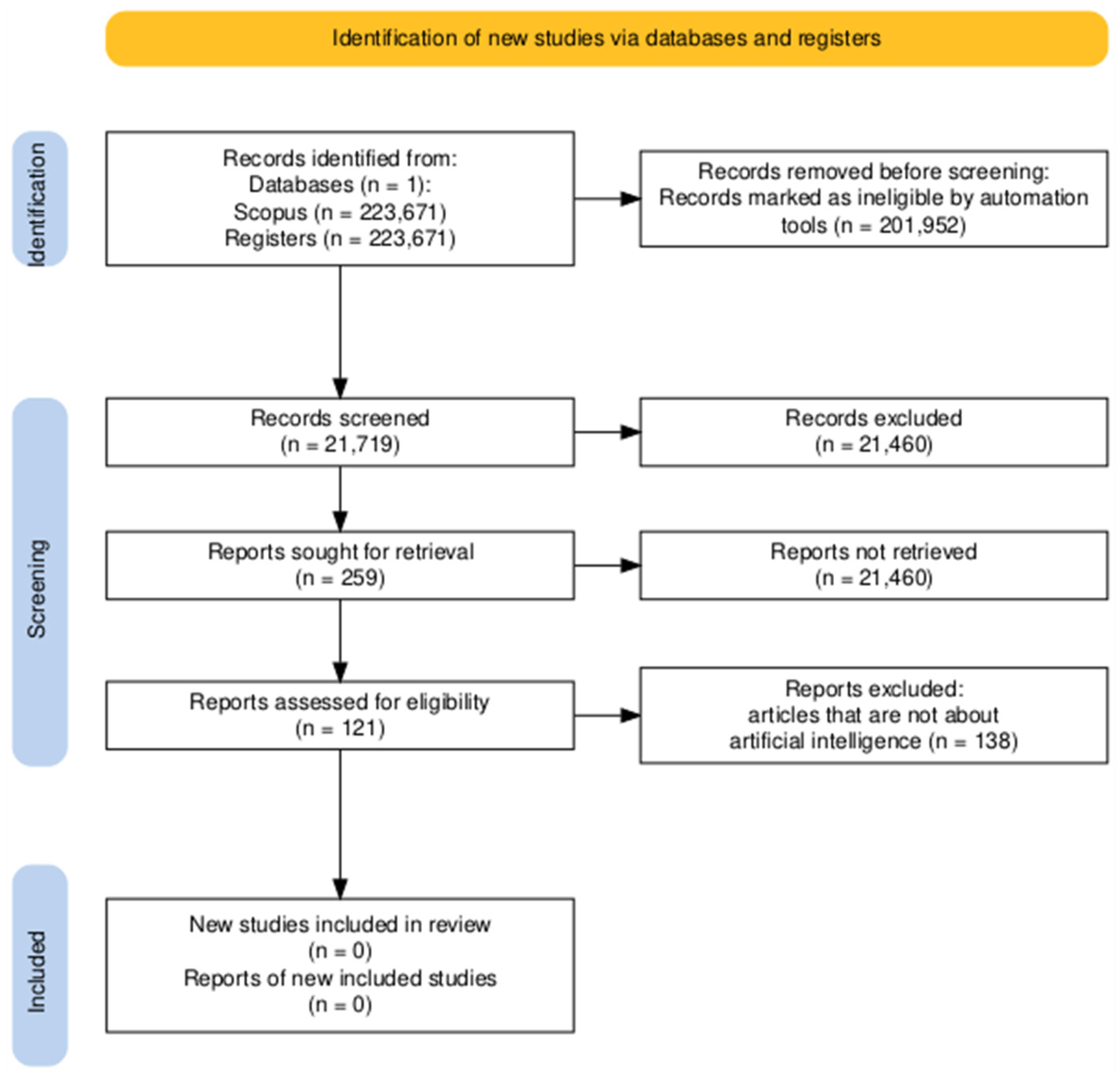

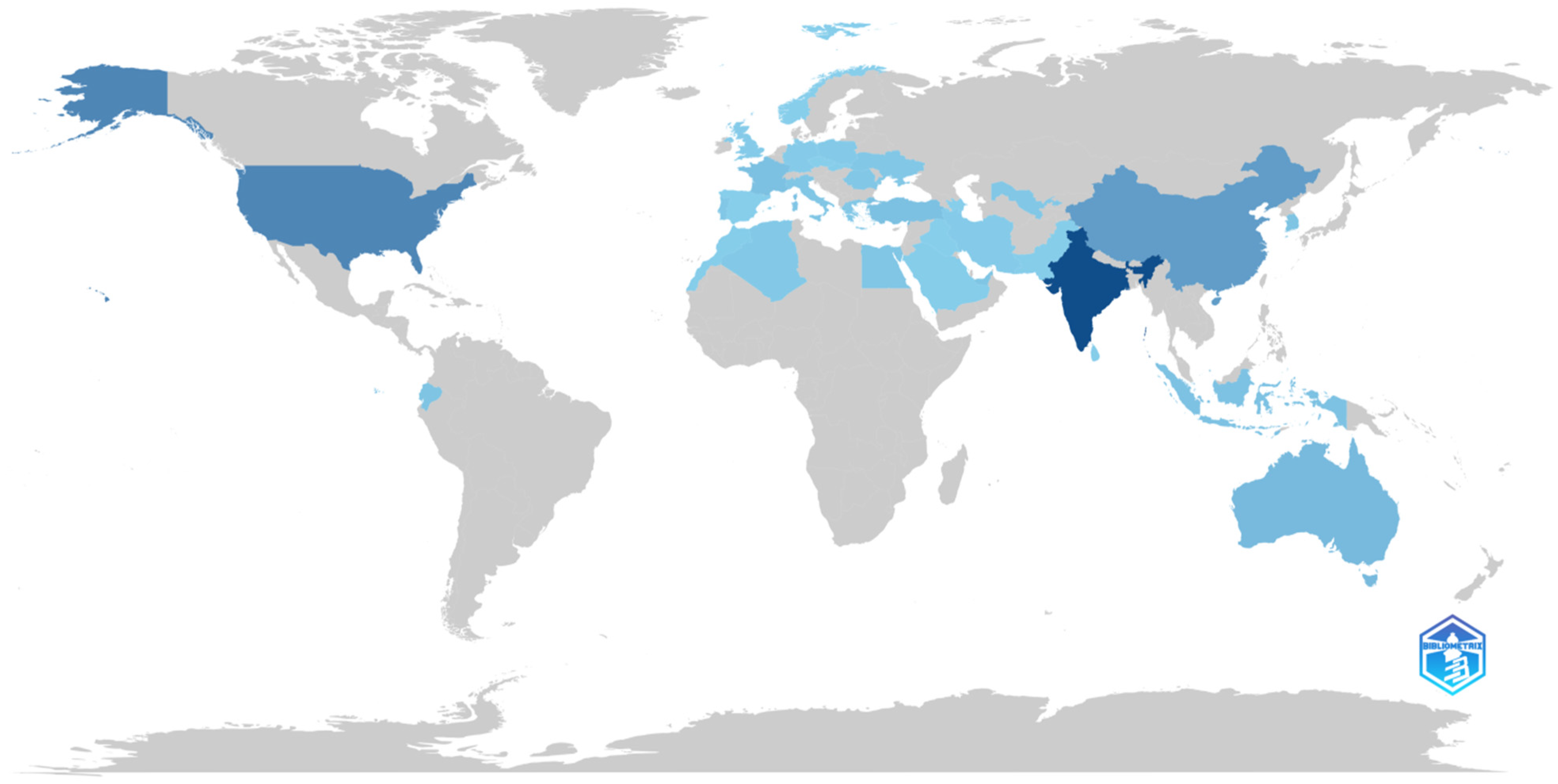
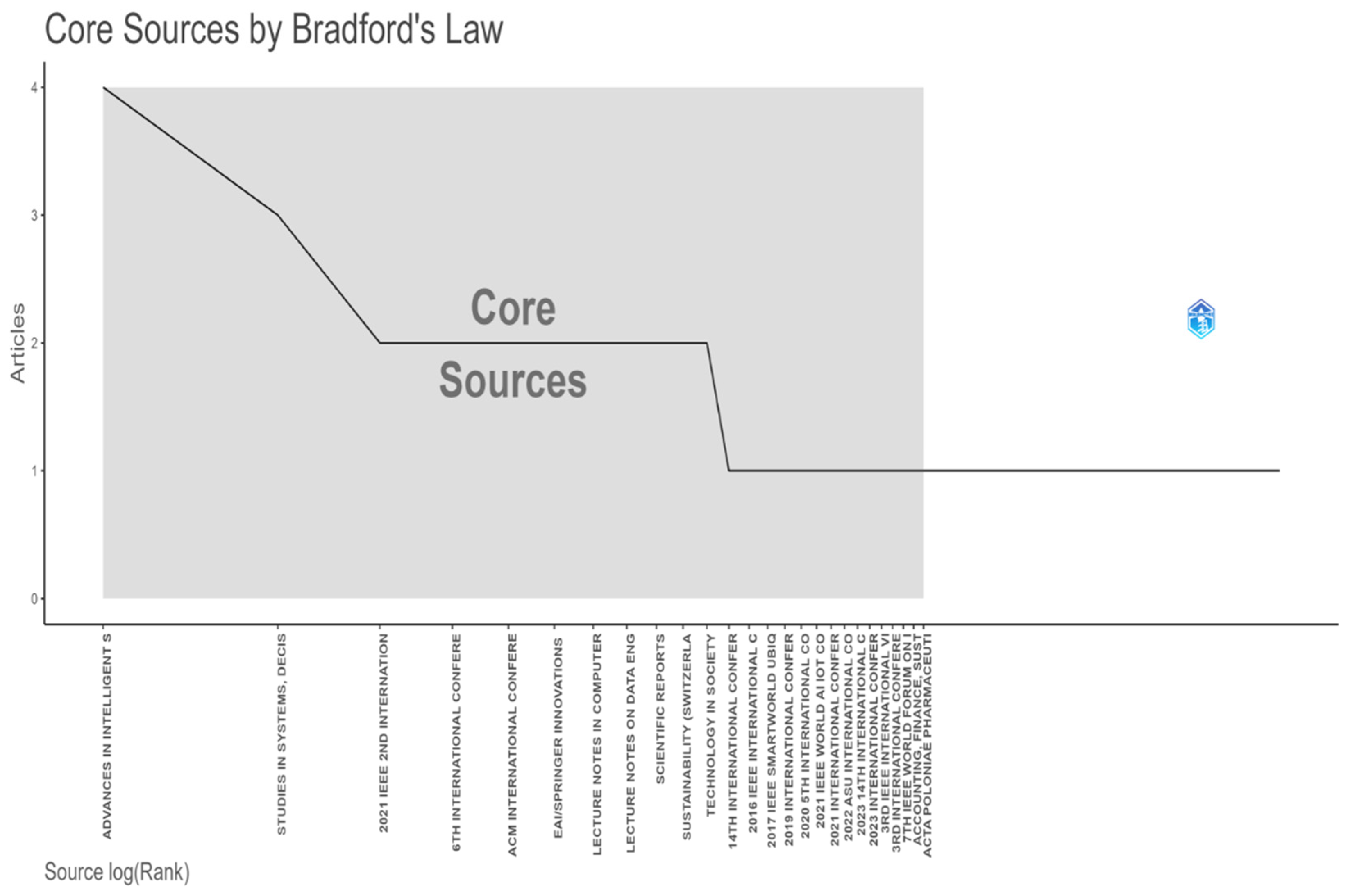


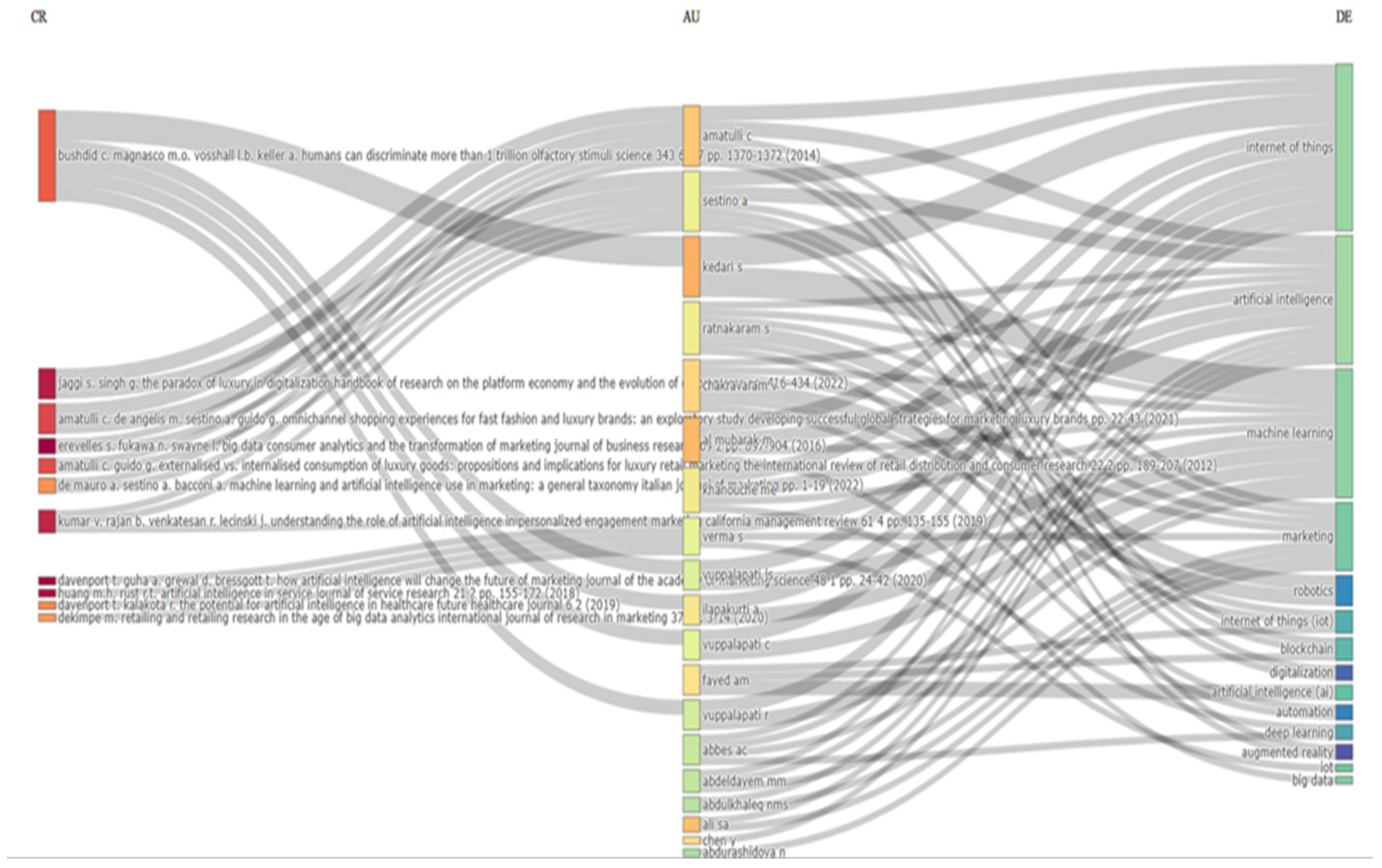
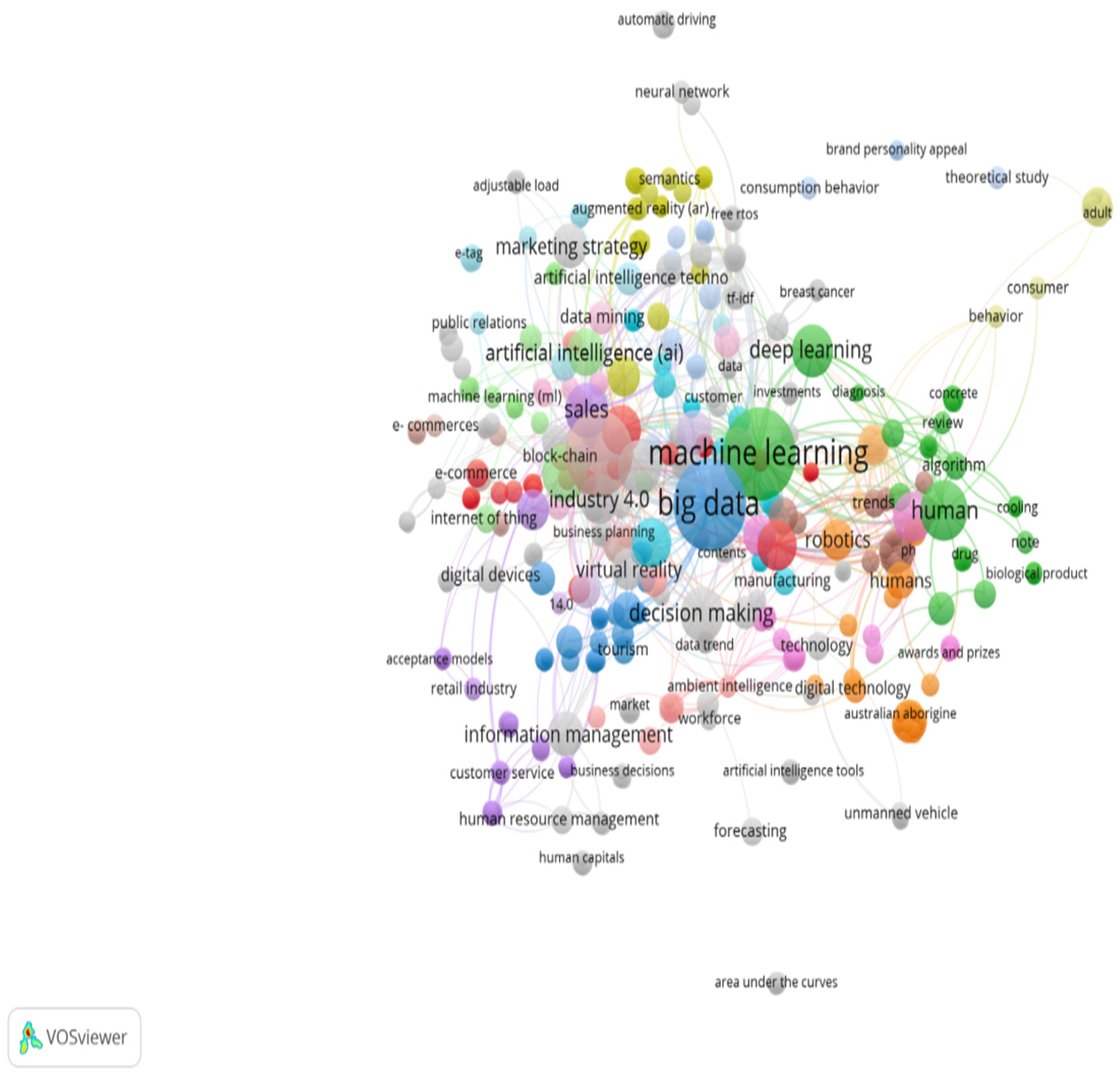


| Fase | Step | Description |
|---|---|---|
| Exploration | Step 1 | Formulating the research problem |
| Step 2 | Searching for appropriate literature | |
| Step 3 | Critical appraisal of the selected studies | |
| Step 4 | Data synthesis from individual sources | |
| Interpretation | Step 5 | Reporting findings and recommendations |
| Communication | Step 6 | Presentation of the LRSB report |
| Database Scopus | Screening | Publications |
|---|---|---|
| Meta-search | Keyword: Internet of Things | 223,671 |
| First inclusion criteria | Keyword: Internet of Things; artificial intelligence | 21,719 |
| Second inclusion criteria | Keyword: Internet of Things; artificial intelligence; marketing | 259 |
| Screening | Keyword: Internet of Things; artificial intelligence; marketing Exact keyword: artificial intelligence Until February 2025 | 121 |
| Country | Number of Publications |
|---|---|
| India | 106 |
| USA | 58 |
| China | 39 |
| Australia | 16 |
| France | 11 |
| Turkey | 11 |
| Indonesia | 10 |
| Ecuador | 9 |
| South Korea | 9 |
| United Arab Emirates | 8 |
Disclaimer/Publisher’s Note: The statements, opinions and data contained in all publications are solely those of the individual author(s) and contributor(s) and not of MDPI and/or the editor(s). MDPI and/or the editor(s) disclaim responsibility for any injury to people or property resulting from any ideas, methods, instructions or products referred to in the content. |
© 2025 by the authors. Licensee MDPI, Basel, Switzerland. This article is an open access article distributed under the terms and conditions of the Creative Commons Attribution (CC BY) license (https://creativecommons.org/licenses/by/4.0/).
Share and Cite
Rosário, A.T.; Raimundo, R.J. The Integration of AI and IoT in Marketing: A Systematic Literature Review. Electronics 2025, 14, 1854. https://doi.org/10.3390/electronics14091854
Rosário AT, Raimundo RJ. The Integration of AI and IoT in Marketing: A Systematic Literature Review. Electronics. 2025; 14(9):1854. https://doi.org/10.3390/electronics14091854
Chicago/Turabian StyleRosário, Albérico Travassos, and Ricardo Jorge Raimundo. 2025. "The Integration of AI and IoT in Marketing: A Systematic Literature Review" Electronics 14, no. 9: 1854. https://doi.org/10.3390/electronics14091854
APA StyleRosário, A. T., & Raimundo, R. J. (2025). The Integration of AI and IoT in Marketing: A Systematic Literature Review. Electronics, 14(9), 1854. https://doi.org/10.3390/electronics14091854







